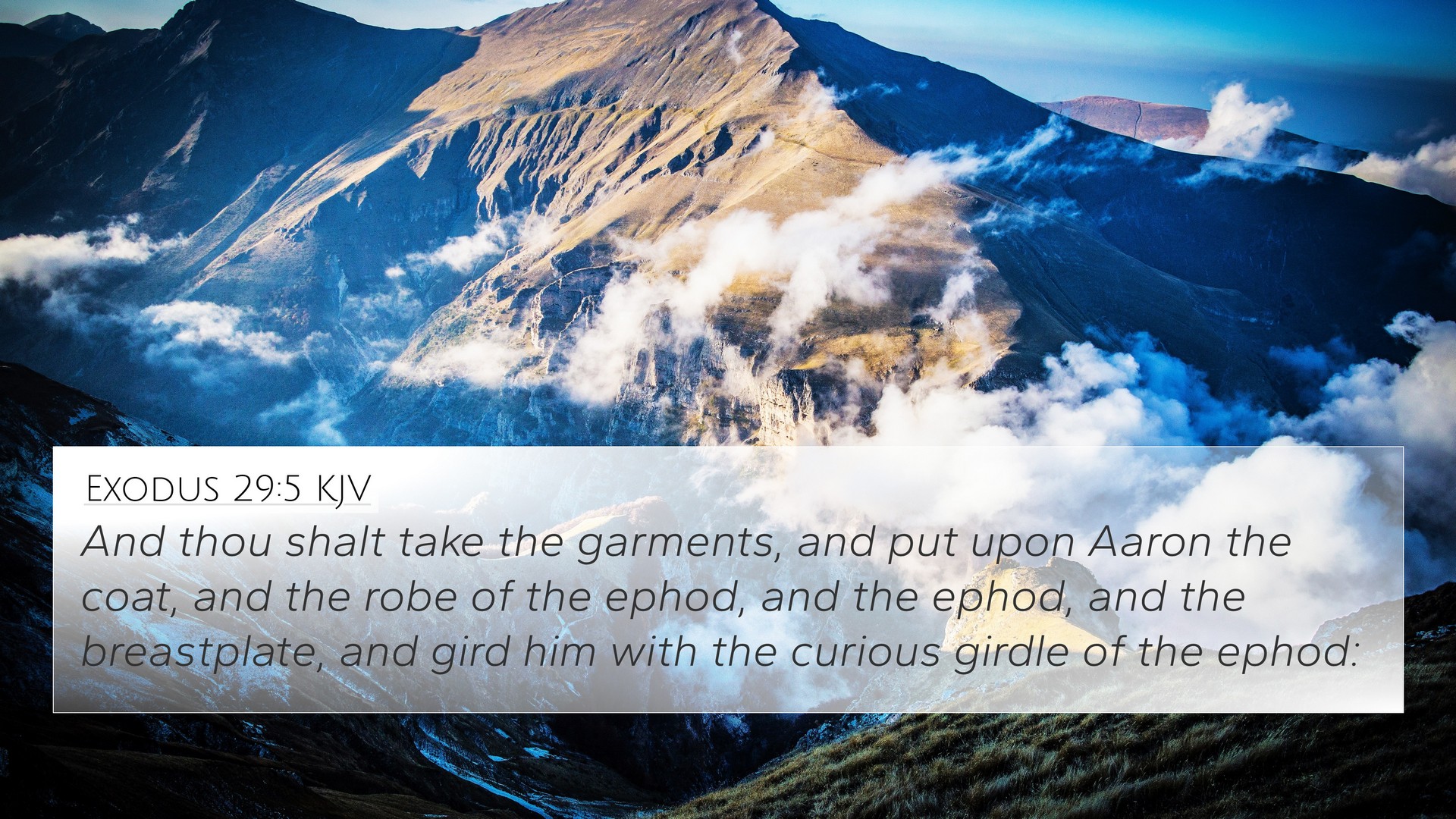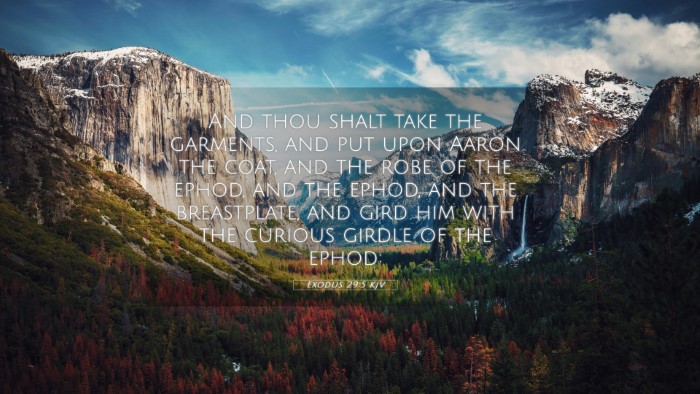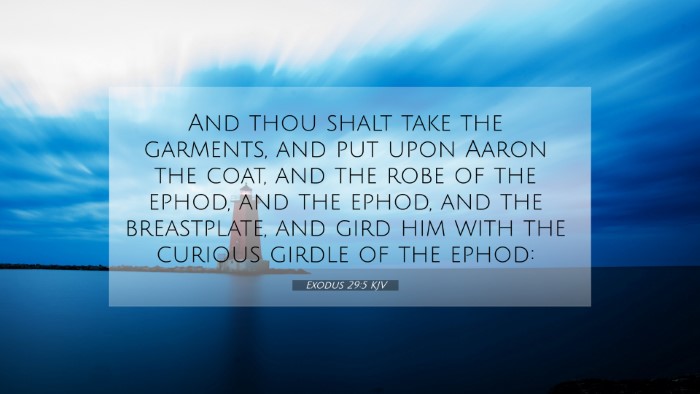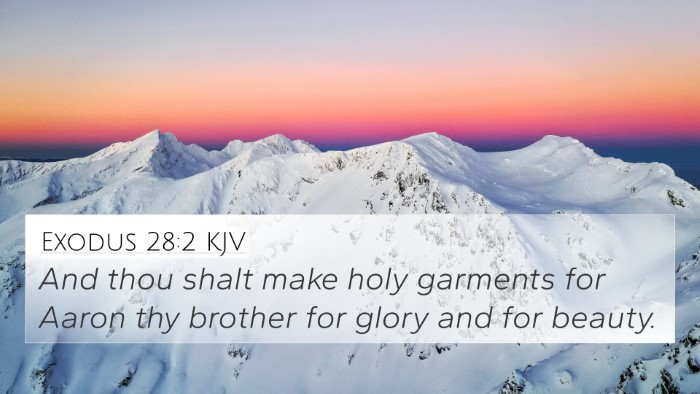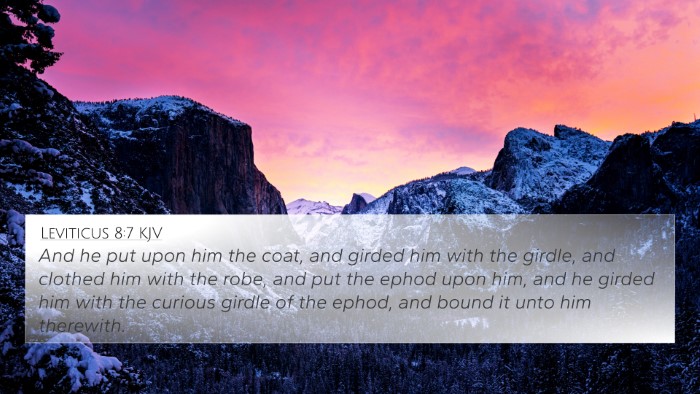Exodus 29:5 - Commentary and Interpretation
Exodus 29:5 states:
“And you shall take the garments, and put on Aaron the coat, and the robe of the ephod, and the ephod, and the breastplate, and gird him with the curious girdle of the ephod.”
Summary of Exodus 29:5
This verse is part of God's instructions to Moses regarding the anointing and consecration of Aaron and his sons as priests. It highlights the importance of specific garments that symbolize their sacred role.
Significance of Priesthood Garments
The garments described are not mere attire; they serve a profound spiritual significance. Matthew Henry, Albert Barnes, and Adam Clarke provide valuable insights into the implications of these priestly garments:
- Matthew Henry: Focuses on the sacred nature of the garments, emphasizing that each piece carries a symbolic weight in representing God's holiness and the priest's role as a mediator between God and man.
- Albert Barnes: Highlights the importance of the breastplate, which contains the Urim and Thummim, representing God's guidance and the priest's responsibility to discern God's will for the people.
- Adam Clarke: Provides detailed descriptions of the garments, linking their construction to the character of God and the seriousness of the priestly duties they represent.
Bible Cross-References
Understanding Exodus 29:5 can be enhanced through cross-references to other Biblical texts that explore similar themes of priesthood, garments, and consecration:
- Leviticus 8:7-9: Details the actual anointing and dressing of Aaron as the high priest.
- Hebrews 5:4-6: Discusses the role of Christ as our High Priest, establishing connections to the priestly garments as symbols of authority and service.
- 1 Peter 2:9: Refers to believers as a "royal priesthood," linking the concept of priesthood from Aaron’s lineage to all Christians.
- Exodus 28:2: A prior command that emphasizes the beauty and glory of the garments meant for Aaron and his sons.
- Isaiah 61:10: Illustrates the joy and righteousness associated with priestly garments.
- Revelation 1:6: Declares that Christ has made believers to be priests to God, showing continuity in priestly function.
- Matthew 22:12: Includes a parable highlighting the importance of being properly attired for God’s banquet, echoing the significance of spiritual garments.
Thematic Connections
This verse can also be connected thematically with others that discuss holiness, service, and the condition of the heart:
- Holiness: Leviticus 11:44: Calls for the people to be holy because God is holy, paralleling the requirement for the priests' garments to be holy.
- Service to God: Romans 12:1: Encourages believers to present their bodies as living sacrifices, akin to the sacrificial role of the priests.
Comparative Bible Verse Analysis
To enhance one's understanding of Exodus 29:5, one can apply tools for cross-referencing. Comparative analysis of themes and motifs enhances comprehension:
- Using a Bible concordance can help identify other verses discussing priestly duties, garments, and their implications.
- Cross-referencing between Old and New Testament texts regarding the priesthood reveals a covenantal continuity.
- Studying Bible chain references can illuminate the thematic flow concerning the roles of both Old Testament priests and New Testament believers.
- Utilizing a cross-reference Bible study guide provides a structured approach to understand the significance of these scriptures.
Conclusion
In conclusion, Exodus 29:5 is rich with meaning and significance rooted in the themes of priesthood and consecration. It draws connections across various Biblical texts, allowing for a deeper understanding of God's covenant with His people. Through comprehensive Bible cross-reference materials and study methods, one can explore the interconnectedness of scriptures and interpret the broader narrative of God’s redemptive plan.
